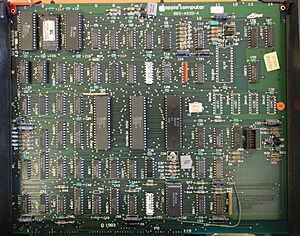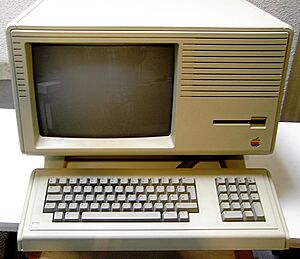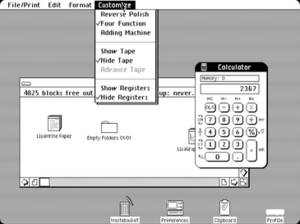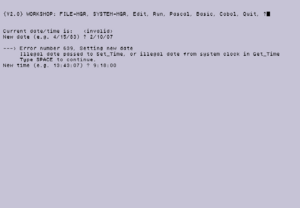Apple Lisa facts for kids
 |
|
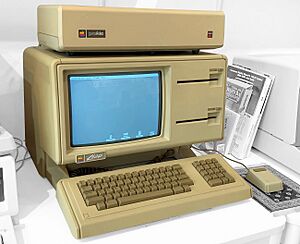
This Lisa has dual 5.25" "Twiggy" floppy drives and a 5 MB ProFile hard disk.
|
|
| Also known as | Locally Integrated Software Architecture |
|---|---|
| Developer | Apple Computer |
| Manufacturer | Apple Computer |
| Type | Personal computer |
| Release date | January 19, 1983 |
| Introductory price | US$9,995 (equivalent to $29,400 in 2022) |
| Discontinued | August 1, 1986 |
| Units sold | 10,000 |
| Operating system | Lisa OS, Xenix |
| CPU | Motorola 68000 @ 5 MHz |
| Memory | 1 MB RAM, 16 KB Boot ROM |
| Display | 12 in (30 cm) monochrome 720×364 |
| Input | Keyboard and mouse |
| Weight | 48 lb (22 kg) |
| Predecessor | Apple II Plus Apple III |
| Successor | Macintosh XL Macintosh |
Lisa is a desktop computer developed by Apple, produced from January 19, 1983 to August 1, 1986, and succeeded by Macintosh. It is generally considered the first mass-market personal computer operable through a graphical user interface (GUI). In 1983, a machine like the Lisa was still so expensive that it was primarily marketed to individual and small and medium-sized businesses as a groundbreaking new alternative to much bigger and more expensive mainframes or minicomputers such as from IBM, that either require additional, expensive consultancy from the supplier, hiring specially trained personnel, or at least, a much steeper learning curve to maintain and operate. Earlier GUI-controlled personal computers were not mass-marketed; for example, Xerox PARC manufactured its Alto workstation only for Xerox and select partners from the early to mid-1970s.
Development of project "LISA" began in 1978. It underwent many changes and shipped at US$9,995 (equivalent to $29,400 in 2022) with a five-megabyte hard drive. It was affected by its high price, insufficient software, unreliable FileWare (codename Twiggy) floppy disks, and the imminent release of the cheaper and faster Macintosh. Only 60,000 Lisa units were sold in two years.
Lisa was considered a commercial failure but with technical acclaim, introducing several advanced features that reappeared on the Macintosh and eventually IBM PC compatibles. These include an operating system with memory protection and a document-oriented workflow. The hardware is more advanced overall than the following Macintosh, including hard disk drive support, up to 2 megabytes (MB) of random-access memory (RAM), expansion slots, and a larger, higher-resolution display.
Lisa's CPU and the storage system were strained by the complexity of the operating system and applications, especially its office suite, and by the ad hoc protected memory implementation, due to the lack of a Motorola memory management unit. Cost-cutting measures that target the consumer market, and the delayed availability of the 68000 processor and its impact on the design process, made the user experience sluggish. The workstation-tier high price and lack of a technical software application library made it a difficult sale for all markets. The IBM PC's popularity and Apple's decision to compete with itself through the lower-priced Macintosh also hindered Lisa's acceptance.
In 1982, after Steve Jobs was forced out of the Lisa project by Apple's board of directors, he appropriated the Macintosh project from Jef Raskin, who had conceived of a sub-$1,000 (equivalent to $4,000 in 2022) text-based appliance computer in 1979. Jobs immediately redefined Macintosh as a less expensive and more focused version of the graphical Lisa.
Macintosh's launch in January 1984 quickly surpassed Lisa's underwhelming sales. Jobs began assimilating increasing numbers of Lisa staff, as he had done with the Apple II division upon taking Raskin's project. Newer Lisa models addressed its shortcomings but, even with a major price reduction, the platform failed to achieve sales volumes comparable to the much less expensive Mac. The Lisa 2/10 is the final model, then rebranded as the high-end Macintosh XL.
Contents
History
Development
Name
Though the original documentation only refers to it as "The Lisa", Apple officially stated that the name was an acronym for "Locally Integrated Software Architecture". Because Steve Jobs's first daughter was named Lisa Nicole Brennan (born in 1978), it was sometimes inferred that the name also had a personal association, and perhaps that the acronym was a backronym contrived later to fit the name. Andy Hertzfeld said that the acronym was reverse-engineered from the name "Lisa" in late 1982 by the Apple marketing team after they had hired a marketing consultancy firm to find names to replace "Lisa" and "Macintosh" (at the time considered by Jef Raskin to be merely internal project codenames) and then rejected all of the suggestions. Privately, Hertzfeld and the other software developers used "Lisa: Invented Stupid Acronym", a recursive backronym, and computer industry pundits coined the term "Let's Invent Some Acronym" to fit Lisa's name. Decades later, Jobs told his biographer Walter Isaacson: "Obviously it was named for my daughter."
Research and design
The project began in 1978 as an effort to create a more modern version of the then-conventional design epitomized by the Apple II. A ten-person team occupied its first dedicated office at 20863 Stevens Creek Boulevard next to the Good Earth restaurant, and nicknamed "the Good Earth building". Initial team leader Ken Rothmuller was soon replaced by John Couch, under whose direction the project evolved into the "window-and-mouse-driven" form of its eventual release. Trip Hawkins and Jef Raskin contributed to this change in design. Apple's co-founder Steve Jobs was involved in the concept.
At Xerox's Palo Alto Research Center (PARC), research had already been underway for several years to create a new humanized way to organize the computer screen, which became known as the desktop metaphor. Steve Jobs visited PARC in 1979 and was absorbed and excited by the revolutionary mouse-driven GUI of the Alto. By late 1979, Jobs successfully negotiated a sale of Apple stock to Xerox, in exchange for his Lisa team receiving two demonstrations of ongoing research projects at PARC. When the Apple team saw the demonstration of the Alto computer, they were able to see in action the basic elements of what constituted a workable GUI. The Lisa team put a great deal of work into making the graphical interface a mainstream commercial product.
The Lisa was a major project at Apple, which reportedly spent more than $50 million on its development. More than 90 people participated in the design, plus more in the sales and marketing effort, to launch the machine. BYTE magazine credited Wayne Rosing with being the most important person in the development of the computer's hardware until the machine went into production, at which point he became the technical lead for the entire Lisa project. The hardware development team was headed by Robert Paratore. The industrial design, product design, and mechanical packaging were headed by Bill Dresselhaus, the Principal Product Designer of Lisa, with his team of internal product designers and contract product designers from the firm that eventually became IDEO. Bruce Daniels was in charge of applications development, and Larry Tesler was in charge of system software. The user interface was designed in six months, after which the hardware, operating system, and applications were all created in parallel.
In 1982, after Steve Jobs was forced out of the Lisa project, he appropriated the existing Macintosh project, which Jef Raskin had conceived in 1979 and led to develop a text-based appliance computer. Jobs redefined Macintosh as a cheaper and more usable Lisa, leading the project in parallel and in secret, and substantially motivated to compete with the Lisa team.
In September 1981, below the announcement of the IBM PC, InfoWorld reported on Lisa, "McIntosh", and another Apple computer secretly under development "to be ready for release within a year". It described Lisa as having a 68000 processor and 128KB RAM, and "designed to compete with the new Xerox Star at a considerably lower price". In May 1982, the magazine reported that "Apple's yet-to-be-announced Lisa 68000 network work station is also widely rumored to have a mouse." Apple Confidential said, "Finally, and perhaps most damaging, even before the Lisa began shipping in June, the press was full of intentionally-leaked rumors about a fall release of a 'baby Lisa' that would work in much the same way, only faster and cheaper. Its name: Macintosh."
Launch
Lisa was launched on January 19, 1983. Its low sales were quickly surpassed by the January 1984 launch of the Macintosh. Newer versions of the Lisa were introduced that addressed its faults and lowered its price considerably, but it failed to achieve sales comparable to the much less expensive Mac. The Macintosh project assimilated a lot more Lisa staff. The final revision, the Lisa 2/10, was modified and sold as the Macintosh XL.
Discontinuation
The high cost and the delays in its release date contributed to the Lisa's discontinuation although it was repackaged and sold at $4,995, as the Lisa 2. In 1986, the entire Lisa platform was discontinued.
In 1987, Sun Remarketing purchased about 5,000 Macintosh XLs and upgraded them. In 1989, with the help of Sun Remarketing, Apple disposed of approximately 2,700 unsold Lisa units in a guarded landfill in Logan, Utah, to receive a tax write-off on the unsold inventory. Some leftover Lisa computers and spare parts were available until Cherokee Data (which purchased Sun Remarketing) went out of business.
Timeline of Lisa models

Overview
Hardware
The Lisa was first introduced on January 19, 1983. It is one of the first personal computer systems with a graphical user interface (GUI) to be sold commercially. It uses a Motorola 68000 CPU clocked at 5 MHz and has 1 MB of RAM. It can be upgraded to 2 MB and later shipped with as little as 512 kilobytes. The CPU speed and model were not changed from the release of the Lisa 1 to the repackaging of the hardware as Macintosh XL.
The real-time clock uses a 4-bit integer and the base year is defined as 1980; the software won't accept any value below 1981, so the only valid range is 1981–1995. The real-time clock depends on a 4 × AA-cell NiCd pack of batteries that only lasts for a few hours when main power is not present. Prone to failure over time, the battery packs could leak corrosive alkaline electrolyte and ruin the circuit boards.
The integrated monochrome black-on-white monitor has 720 × 364 rectangular pixels on a 12-inch (30 cm) screen.
Lisa's printer support includes Apple's Dot Matrix, Daisy Wheel, and ImageWriter dot matrix printers, and Canon's new color inkjet technology.
The original Lisa, later called the Lisa 1, has two FileWare 5.25-inch double-sided variable-speed floppy disk drives, more commonly known by Apple's codename "Twiggy". They have what was then a very high capacity of approximately 871 kB each, but are unreliable and use proprietary diskettes. Competing systems with high diskette data storage have much larger 8" floppy disks, seen as cumbersome and old-fashioned for a consumer system.
Lisa 1's innovations include block sparing, to reserve blocks in case of bad blocks, even on floppy disks. Critical operating system information has redundant storage, for recovery in case of corruption.
Lisa 2
The first hardware revision, the Lisa 2, was released in January 1984 and was priced between $3,495 and $5,495. It was much less expensive than the original model, and dropped the Twiggy floppy drives in favor of a single 400K Sony microfloppy. The Lisa 2 has as little as 512 KB of RAM. The Lisa 2/5 consists of a Lisa 2 bundled with an external 5- or 10-megabyte hard drive. In 1984, at the same time the Macintosh was officially announced, Apple offered free upgrades to the Lisa 2/5 to all Lisa 1 owners, by replacing the pair of Twiggy drives with a single 3.5-inch drive, and updating the boot ROM and I/O ROM. In addition, the Lisa 2's new front faceplate accommodates the reconfigured floppy disk drive, and it includes the new inlaid Apple logo and the first Snow White design language elements. The Lisa 2/10 has a 10 MB internal hard drive, no parallel port, and a standard configuration of 1 MB of RAM.
Developing early Macintosh software required a Lisa 2. There were relatively few third-party hardware offerings for the Lisa, as compared to the earlier Apple II—AST offered a 1.5 MB memory board which, when combined with the standard Apple 512 KB memory board, expanded the Lisa to a total of 2 MB of memory, the maximum amount that the MMU can address.
Late in the product life of the Lisa, there were third-party hard disk drives, SCSI controllers, and double-sided 3.5-inch floppy-disk upgrades. Unlike the original Macintosh, the Lisa has expansion slots. The Lisa 2 motherboard has a very basic backplane with virtually no electronic components, but plenty of edge connector sockets and slots. There are two RAM slots, one CPU upgrade slot, and one I/O slot, all in parallel. At the other end are three Lisa slots in parallel.
Macintosh XL
In January 1985, following the Macintosh, the Lisa 2/10 (with integrated 10 MB hard drive) was rebranded as Macintosh XL. It was given a hardware and software kit, enabling it to reboot into Macintosh mode and positioning it as the high-end Macintosh. The price was lowered yet again, to $4,000, and sales tripled, but CEO John Sculley said that Apple would have lost money increasing production to meet the new demand. Apple discontinued the Macintosh XL, leaving an eight-month void in Apple's high-end product line until the Macintosh Plus was introduced in 1986.
Software
Lisa OS
The Lisa operating system features protected memory, enabled by a crude hardware circuit compared to the Sun-1 workstation (c. 1982), which features a full memory management unit. Motorola did not have an MMU (memory-management unit) for the 68000 ready in time, so third parties developed their own. Apple's is also the result of a cost-cutting compromise, with sluggish performance. Based, in part, on elements from the Apple III SOS operating system released three years earlier, Lisa's disk operating system also organizes its files in hierarchical directories. File system directories correspond to GUI folders, as with previous Xerox PARC computers from which Lisa borrowed heavily. Lisa was designed around a hard drive, unlike the first Macintosh.
Lisa has two main user modes: the Lisa Office System and the Workshop. The Lisa Office System is the GUI environment for end users. The Workshop is a program development environment and is almost entirely text-based, though it uses a GUI text editor. The Lisa Office System was eventually renamed 7/7 which refers to the seven supplied application programs: LisaWrite, LisaCalc, LisaDraw, LisaGraph, LisaProject, LisaList, and LisaTerminal.
Apple's warranty said that this software works precisely as stated, and Apple refunded an unspecified number of users, in full, for their systems. These operating system frailties, and costly recalls, combined with the very high price point, led to the failure of the Lisa in the marketplace. NASA purchased Lisa machines, mainly to use the LisaProject program.
In 2018, the Computer History Museum announced it would be releasing the source code for Lisa OS, following a check by Apple to ensure this would not impact other intellectual property. For copyright reasons, this release does not include the American Heritage dictionary. For its 40th anniversary on January 19, 2023, Lisa OS Software version 3.1's source code is available under an Apple Academic License Agreement.
MacWorks
In April 1984, following the release of the Macintosh, Apple introduced MacWorks, a software emulation environment that allows the Lisa to run Macintosh System software and applications. MacWorks helped make the Lisa more attractive to potential customers, although it did not enable the Macintosh emulation to access the hard disk until September because early versions of the Macintosh operating system lack hard disk support. In January 1985, it was re-branded MacWorks XL as the primary system application, to turn the Lisa into the Macintosh XL.
Third-party software
A significant impediment to third-party Lisa software was the fact that the launch version of Lisa Office System can not be used to program its applications. Its development requires the separate OS, Lisa Workshop and programmers select one of the two OSes at startup. Lisa Workshop was used to develop Macintosh software for its first few years, and a Macintosh-native development system was released. For most of its lifetime, the Lisa never went beyond the original seven applications that Apple had deemed enough to "do everything". UniPress Software released UNIX System III for $495 (equivalent to $1,500 in 2022).
Santa Cruz Operation (SCO) published Microsoft Xenix (version 3), a Unix-like command-line operating system for the Lisa 2, and Microsoft's Multiplan 2.1 spreadsheet for Xenix. Other Lisa Xenix third parties include Quadratron's Q-Office suite.
Legacy
The Macintosh project, led by Steve Jobs, borrowed heavily from Lisa's GUI paradigm and directly took many of its staff, to create Apple's flagship platform of the next several decades. The column-based interface, for instance, utilized by Mac OS X, had originally been developed for Lisa. It had been discarded in favor of the icon view.
Apple's culture of object-oriented programming on Lisa contributed to the 1988 conception of Pink, the first attempt to re-architect the operating system of Macintosh.
In 1989, Wayne Rosing reflected on his time at Apple after his move to Sun Microsystems, recalling that building the Lisa was hard work, that the machine had needed a hard disk and enough memory, and is still slow. Yet, he noted, the level of integration between applications in the Lisa had not since been achieved by Apple.
See also
- People:
- Bill Atkinson
- Rich Page
- Brad Silverberg
- Technology:
- History of the graphical user interface
- Cut, copy, and paste
- Visi On
- GEMDOS (adaptation for Lisa 2/5)


